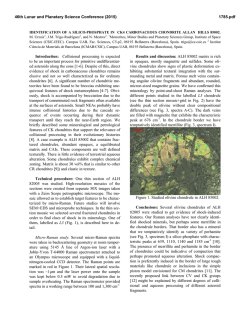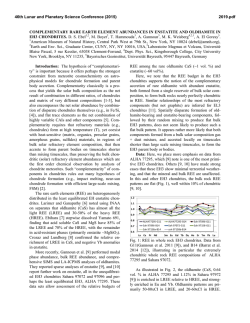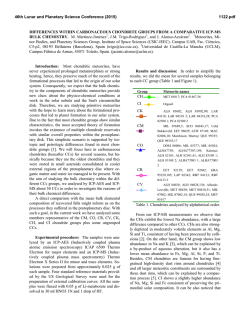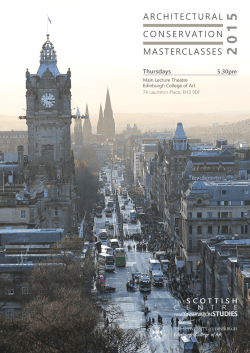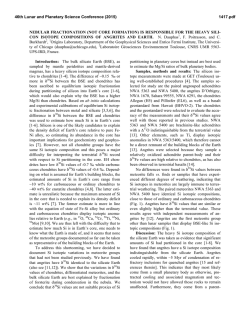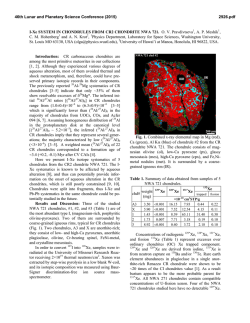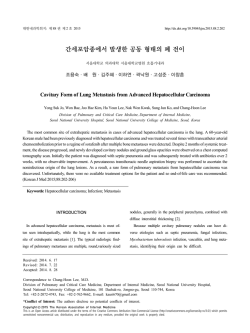
Metal-Sulfide Nodules in ALH 81189 Highly Primitive EH3 Chondrite
46th Lunar and Planetary Science Conference (2015) 2133.pdf METAL-SULFIDE NODULES IN THE ALH 81189 HIGHLY PRIMITIVE EH3 CHONDRITE AND THE ORIGIN OF ENSTATITE CHONDRITE COMPONENTS. M. K. Weisberg1,2,3 and D. S. Ebel2,3,4. 1Dept. Phys. Sci., Kingsborough College, City University New York, Bklyn, NY 11235. ([email protected]) 2Earth and Env. Sci., Graduate Center, CUNY, NY, NY 10016, USA. 3Dept. Earth Planet. Sci., American Museum Natural History, NY, NY 10024, USA. 4Lamont-Doherty Observatory, Columbia Universtiy, NY, NY. Introduction: The enstatite chondrites (EC) have important implications for the evolution of the Earth, inner Solar System and asteroid belt. They represent extremes in the conditions that resulted in the properties of chondrites. Their silicate, sulfide, and metal compositions record highly reducing conditions [e.g., 1, 2]. They are the only chondrites with oxygen as well as Cr, Ti, Ni and Zn stable isotope compositions similar to the earth and moon [3-5], but Si isotopes differ, supplying evidence against a direct relationship between E chondrites and the Earth [6, 7]. Most ECs are completely dry, lacking any evidence of hydrous alteration; the only exception are EC clasts in the Kaidun breccia which contain hydrous minerals [8]. Thus, ECs likely formed within the snow line and are good candidates to be building blocks of the inner planets [9]. Metal and sulfide in both EH3 and EL3 chondrites are present as decrete nodules with complex mineral assemblages. EH3 metal-sulfide assemblages wereshown to contain a variety of primary and secondary sulfides [e.g., 10] and to have complex, in some cases layered mineral asseblages that include minor amounts of silicates (enstatite and silica). These layered objects were interpreted to have formed through progressive condensation in a reduced nebula [11, 12]. Studies of textural relationships in chondrules and silica–sulfide-rich assemblages suggest that reaction with an external S-rich gaseous reservoir under conditions of high ƒS2 during melting played a role in EH chondrite history [13]. In EL3 chondrites, metal-sulfide nodules are texturally and mineralogically distinct from those in EH3 [14, 15]. The EL3 nodules are about 200300 µm in size and about 10 vol% of EL3 chondrites. They have sharp boundaries with matrix and enclose complex assemblages of enstatite, albitic plagioclase, silica, schreibersite (FeNiP), troilite, daubreelite and/or graphite. Enstatite in the metal occurs as needles and laths. The origins of both EL3 chondrites and the metal nodules they contain have been controversial. They have been interpreted to be breccias with regions of impact melt and the metal nodules with their enstatite intergrowths have been interpreted to be products of impact melting with mobilization of the metal and injection into the pores of the EL3 regolith [14, 16]. Alternatively, it has been argued that the EL3 metal nodules are primary early Solar System materials [13]. Here we present a study of metal-sulfide nodules in the ALH 81189 EH3 chondrite, selected because it is probably one of the most primitive EH3 chodrites [17]. Thus, it may provide an important window into the formation of metal-sulfide-silicate assemblages in EH3 chondrites and the role of reduction and/or sulfidation in the formation of EC components. Results: We studied 10 metal-sulfide nodules in thin section ALH 81189, 3, supplied by ANSMET and MWG. The nodules are generally sharply bound, round to sub-round in shape with smooth to ragged or lobate edges (Fig. 1, 2) and range up to ~500µm in size (avg. size = 340µm). They range from being Si-bearing FeNi metal-dominated to FeS (troilite)-dominated. Some troilite is associated with small amounts of daubreelite [FeCr2S4], possibly a subsolidus exsolution from the troilite. Both FeNi metal and troilite contain small (1-2 µm-size) grains of shreibersite [(FeNi)3P] and some metal is associated with perryite [(Ni,Fe)5(Si,P)2] (e.g., Fig. 2). The perryite generally occurs as small grains within or as fine intergrowths with the metal. Some perryites may be condensates trapped in metal or it cocrystallized with or exsolved from metal. One of the troilite-dominated nodules contains a 70µm area of sphalerite [(Zn,Fe)S]. One of the intrguging aspects of the metal-sulfide nodules is that some contain lithic silicate fragments. Silica and enstatite are common in the metal-sulfide nodules in the Sahara 97096 EH3 chondrite, in some cases occurring as a fine layer in multi-layered nodules [11, 12]. In EL3 metal nodules silica and enstatite generally are present as small blades [14, 15]. However, in the ALH 81189 (EH3) nodules, the silicates are commonly lithic fragments consisting of assemblages of enstatite, silica and Na-,Ca-feldspar and/or glass (Fig. 1) with mineral compositions typical of EH3 chondrules and matrix. The silicate fragments are generally irregular in shape and have textures that suggest they are chondrule fragments. However, some of the fragments are dominated by silica and some consist of sub-micron-sized silicate grains, which is unlike typical EH chondrules. One unusal object appears (in thin section) to be a semi-ring of metal surrounding a mixture of chondrule fragments (Fig. 2). Discussion: The metal-sulfide nodules are sharply bound primary objects that accreted together with the chondrules to form the EH chondrites. They were freefloating objects in the nebula: a kind of chondrule. Layered metal-sulfide nodules in the Sahara 97096 EH3 chondrite have mineral assemblages and crystalli- 46th Lunar and Planetary Science Conference (2015) zation sequences consistent with condensation from a Solar gas under reducing condtions [11]. Study of trace elements in the metal, shreibersite and perryite in metal-sulfide nodules indicate they are preaccretionary objects that retain CI ratios of siderophile elements [12]. However, nodules were likely modified by various degrees of melting and possibly sulfidation [12]. We propose that the nodules in ALH 81189 formed by partial melting of sulfide-metal rich precursor assemblages. Some perryite in contact with troilite has been interpreted to be a product of sulfidation of FeNi metal [e.g., 12,18]. However, in the nodules we studied, perryite generally does not occur in contact with troilite and therefore we interpret it to be relict condensate grains trapped in cooling metal, co-crystallized with the FeNi metal or formed by exsolution from the metal. The presence of silicate-rich, chondrule-like fragments in the metal-sulfide nodules in ALH 81189 suggests that the metal-sulfide nodules postdate or are contemporaneous with chondrule formation. We did not observe any direct evidence of sulfidation in the nodules we studied but, in a sulfidation scenario [12] the silicate fragments in the nodules could be interpreted to be remants of silicate material that survived sulfidation. However, the textures suggest a mechanical process is more likely. The silicates appear to be relict chondrule fragments that were incorporated into sulfide-metal liquids possibly during the transient heating events of chondrule formation. Thus the metal-sulfide nodules were likely assemblages of metal and sulfide grains that were melted, partially melted or re-melted (recycled) during chondrule formation, trapping broken fragments of an early generation of chondrules. Acknowledgments: This research is supported by NASA Cosmochemistry grants NNX12AI06G (MKW), NNX10AI42G (DSE). Samples were supplied by ANSMET through the MWG References: [1] Keil K. (1968) Jour. Geophys. Res. 73, 6945-6076. [2] Weisberg M. K. and Kimura M. (2012) Chemie der Erde 72, 101–115. [3] Javoy M. (1995) Geophys. Res. Lett., 22, 2219-2222 [4] Warren P. (2011) Earth Planet. Sci. Lett. 311, 93-100. [5] Paniello R. C. (2012) Nature 490, 376-379. [6] Fitoussi C. and Bourdon B. (2012) Science 335, 1477– 1480. [7] Savage P.S. and Moynier F. (2013), Earth Planet. Sci. Lett. 91, 1-18. [8] Zolensky M. E. and Ivanov A. (2004) Chemie der Erde 63, 185-246. [9] Ebel D.S. and Alexander C.M.O'D. (2011) Planet. Space Sci. 59, 1888-1894. [10] El Goresy A. et al. (1988) Nat. Inst. Polar Res. Symp. Antarct. Meteorites 1, 65–101. [11] Weisberg M.K. and Prinz M. (1988). Lunar Planet. Sci Conf. 29, # 1741. [12] Lehner S.W. et al. (2010) MAPS 45, 289-303. [13] Lehner S.W. et al. (2012) Geochim. Cosmochim. Acta 101, 34-56. [14] Van Niekirk, D. and Keil, K. (2011) Meteorit. & Plan- 2133.pdf et. Sci 46, 1487-1494. [15] Weisberg M. K. et al. (2013) LPSC 44, #287. [16] Van Niekerk D et al. (2009) Lunar Planet. Sci Conf. 40, #2049. [17] Weisberg M. K. (2014) et al. 77th Met. Soc., #5357. [18] Rambaldi E. R. (1986) Meteoritics 21, 23-31. Fig. 1 Backscattered electron image of M10 in ALH 81189. M10 is dominated by FeNi with lesser amounts of troilite, minor daubreelite and schreibersite and contains silicate inclusions that appear to be chondrule fragments. Fig. 2. Backscattered electron images of metal nodule M7 in ALH 81189 (top) and enlargement showing the rim (bottom). M7 consists of an interior portion consisting of FeNi, FeS and chondrule frgaments. The outer layer (rim) consists of a fine integrowth of FeNi and perryite.
© Copyright 2026
